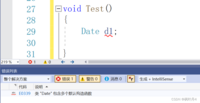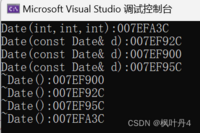目录
1 -> 类的六个默认成员函数
2 -> 构造函数
2.1 -> 概念
2.2 -> 特性
3 -> 析构函数
3.1 -> 概念
3.2 -> 特性
4 -> 拷贝构造函数
4.1 -> 概念
4.2 -> 特征
5 -> 赋值运算符重载
5.1 -> 运算符重载
5.2 -> 赋值运算符重载
5.3 -> 前置++和后置++重载
6 -> 日期类的实现
7 -> const成员
8 -> 取地址及const取地址操作符重载

1 -> 类的六个默认成员函数
如果一个类中什么成员都没有,简称为空类。 空类中真的什么都没有吗?并不是,任何类在什么都不写时,编译器会自动生成以下6个默认成员 函数。 默认成员函数:用户没有显式实现,编译器会生成的成员函数称为默认成员函数。 class Date {};
2 -> 构造函数
2.1 -> 概念
对于一下Date类:
#include <iostream>using namespace std;class Date{public:void Init(int year, int month, int day){_year = year;_month = month;_day = day;}void Print(){cout << _year << "-" << _month << "-" << _day << endl;}private:int _year;int _month;int _day;};int main(){Date d1;d1.Init(2024, 2, 4);d1.Print();Date d2;d2.Init(2024, 2, 5);d2.Print();return 0;}对于Date类,可以通过Init公有方法给对象设置日期,但如果每次创建对象时都调用该方法设置信息,未免过于麻烦,那么,能否在对象创建时,就将信息设置进去呢?
构造函数是一个特殊的成员函数,名字与类名相同,创建类类型对象时由编译器自动调用,以保证每个数据成员都有一个合适的初始值,并且在对象整个生命周期内只调用一次。
2.2 -> 特性
构造函数是特殊的成员函数,需要注意的是,构造函数虽然名称叫构造,但是构造函数的主要任 务并不是开空间创建对象,而是初始化对象。 其特征如下:1. 函数名与类名相同;
2. 无返回值;
3. 对象实例化时编译器自动调用对应的构造函数;
4. 构造函数可以重载;
#include <iostream>using namespace std;class Date{public:// 1.无参构造函数Date(){}// 2.带参构造函数Date(int year, int month, int day){_year = year;_month = month;_day = day;}private:int _year;int _month;int _day;};void TestDate(){Date d1; // 调用无参构造函数Date d2(2024, 2, 4); // 调用带参的构造函数Date d3();}注意:如果通过无参构造函数创建对象时,对象后面不用跟括号,否则就成了函数的声明。 如Date d3();声明了d3函数,该函数无参,返回一个日期类的对象。

5. 如果类中没有显式定义构造函数,则C++编译器会自动生成一个无参的默认构造函数,一旦用户显式定义编译器将不再生成;
#include <iostream>using namespace std;class Date{public:// 如果用户显式定义了构造函数,编译器将不再生成/*Date(int year, int month, int day){_year = year;_month = month;_day = day;}*/private:int _year;int _month;int _day;};int main(){Date d1; return 0;}关于编译器生成的默认成员函数,不禁产生疑问:不实现构造函数的情况下,编译器会生成默认的构造函数。但是看起来默认构造函数又没什么用?d对象调用了编译器生成的默认构造函数,但是d对象_year/_month/_day,依旧是随机值。也就说在这里编译器生成的默认构造函数并没有什么用??
6. C++把类型分成内置类型(基本类型)和自定义类型。内置类型就是语言提供的数据类型,如:int/char……,自定义类型就是我们使用class/struct/union等自己定义的类型,观察下面的程序,就会发现编译器生成默认的构造函数会对自定类型成员_t调用的它的默认成员函数。
#include <iostream>using namespace std;class Time{public:Time(){cout << "Time()" << endl;_hour = 0;_minute = 0;_second = 0;}private:int _hour;int _minute;int _second;};class Date{private:// 基本类型(内置类型)int _year;int _month;int _day;// 自定义类型Time _t;};int main(){Date d;return 0;}
#include <iostream>using namespace std;class Time{public:Time(){cout << "Time()" << endl;_hour = 0;_minute = 0;_second = 0;}private:int _hour;int _minute;int _second;};class Date{private:// 基本类型(内置类型)int _year = 2024;int _month = 2;int _day = 4;// 自定义类型Time _t;};int main(){Date d;return 0;}
7. 无参的构造函数和全缺省的构造函数都称为默认构造函数,并且默认构造函数只能有一个。
注意:无参构造函数、全缺省构造函数、我们没写编译器默认生成的构造函数,都可以认为是默认构造函数。
#include <iostream>using namespace std;class Date{public:Date(){_year = 2024;_month = 2;_day = 4;}Date(int year = 2024, int month = 2, int day = 4){_year = year;_month = month;_day = day;}private:int _year;int _month;int _day;};void Test(){Date d1;}
3 -> 析构函数
3.1 -> 概念
析构函数:与构造函数功能相反,析构函数不是完成对对象本身的销毁,局部对象销毁工作是由 编译器完成的。而对象在销毁时会自动调用析构函数,完成对象中资源的清理工作。3.2 -> 特性
析构函数是特殊的成员函数,其特征如下: 1. 析构函数名是在类名前加上字符 ~; 2. 无参数无返回值类型; 3. 一个类只能有一个析构函数。若未显式定义,系统会自动生成默认的析构函数。注意:析构函数不能重载; 4. 对象生命周期结束时,C++编译系统系统自动调用析构函数;#include <iostream>using namespace std;typedef int DataType;class Stack{public:Stack(size_t capacity = 3){_array = (DataType*)malloc(sizeof(DataType) * capacity);if (NULL == _array){perror("malloc申请空间失败!!!");return;}_capacity = capacity;_size = 0;}void Push(DataType data){// CheckCapacity();_array[_size] = data;_size++;}~Stack(){if (_array){free(_array);_array = NULL;_capacity = 0;_size = 0;}}private:DataType* _array;int _capacity;int _size;};void TestStack(){Stack s;s.Push(1);s.Push(2);}#include <iostream>using namespace std;class Time{public:~Time(){cout << "~Time()" << endl;}private:int _hour;int _minute;int _second;};class Date{private:// 基本类型(内置类型)int _year = 2024;int _month = 2;int _day = 4;// 自定义类型Time _t;};int main(){Date d;return 0;}
4 -> 拷贝构造函数
4.1 -> 概念
拷贝构造函数:只有单个形参,该形参是对本类类型对象的引用(一般常用const修饰),在用已存 在的类类型对象创建新对象时由编译器自动调用。4.2 -> 特征
拷贝构造函数也是特殊的成员函数,其特征如下: 1. 拷贝构造函数是构造函数的一个重载形式。 2. 拷贝构造函数的参数只有一个且必须是类类型对象的引用,使用传值方式编译器直接报错,因为会引发无穷递归调用。#include <iostream>using namespace std;class Date{public:Date(int year = 2024, int month = 2, int day = 4){_year = year;_month = month;_day = day;}// Date(const Date& d) // 正确写法Date(const Date& d) // 错误写法:编译报错,会引发无穷递归{_year = d._year;_month = d._month;_day = d._day;}private:int _year;int _month;int _day;};int main(){Date d1;Date d2(d1);return 0;}
#include <iostream>using namespace std;class Time{public:Time(){_hour = 1;_minute = 1;_second = 1;}Time(const Time& t){_hour = t._hour;_minute = t._minute;_second = t._second;cout << "Time::Time(const Time&)" << endl;}private:int _hour;int _minute;int _second;};class Date{private:// 基本类型(内置类型)int _year = 1970;int _month = 1;int _day = 1;// 自定义类型Time _t;};int main(){Date d1;// 用已经存在的d1拷贝构造d2,此处会调用Date类的拷贝构造函数// 但Date类并没有显式定义拷贝构造函数,则编译器会给Date类生成一个默认的拷贝构造函数Date d2(d1);return 0;}#include <iostream>using namespace std;typedef int DataType;class Stack{public:Stack(size_t capacity = 10){_array = (DataType*)malloc(capacity * sizeof(DataType));if (nullptr == _array){perror("malloc申请空间失败");return;}_size = 0;_capacity = capacity;}void Push(const DataType& data){// CheckCapacity();_array[_size] = data;_size++;}~Stack(){if (_array){free(_array);_array = nullptr;_capacity = 0;_size = 0;}}private:DataType* _array;size_t _size;size_t _capacity;};int main(){Stack s1;s1.Push(1);s1.Push(2);s1.Push(3);s1.Push(4);Stack s2(s1);return 0;}

5. 拷贝构造函数典型调用场景: 使用已存在对象创建新对象 函数参数类型为类类型对象 函数返回值类型为类类型对象
#include <iostream>using namespace std;class Date{public:Date(int year, int minute, int day){cout << "Date(int,int,int):" << this << endl;}Date(const Date& d){cout << "Date(const Date& d):" << this << endl;}~Date(){cout << "~Date():" << this << endl;}private:int _year;int _month;int _day;};Date Test(Date d){Date temp(d);return temp;}int main(){Date d1(2024, 2, 4);Test(d1);return 0;}

5 -> 赋值运算符重载
5.1 -> 运算符重载
C++为了增强代码的可读性引入了运算符重载,运算符重载是具有特殊函数名的函数,也具有其返回值类型,函数名字以及参数列表,其返回值类型与参数列表与普通的函数类似。 函数名字为:关键字operator后面接需要重载的运算符符号。 函数原型:返回值类型 operator操作符(参数列表) 注意: 不能通过连接其他符号来创建新的操作符:比如operator@;重载操作符必须有一个类类型参数;用于内置类型的运算符,其含义不能改变,例如:内置的整型+,不能改变其含义;作为类成员函数重载时,其形参看起来比操作数数目少1,因为成员函数的第一个参数为隐藏的this;.* :: sizeof ?: . 注意以上5个运算符不能重载。#include <iostream>using namespace std;// 全局的operator==class Date{public:Date(int year = 1900, int month = 1, int day = 1){_year = year;_month = month;_day = day;}//private:int _year;int _month;int _day;};bool operator==(const Date& d1, const Date& d2){return d1._year == d2._year&& d1._month == d2._month&& d1._day == d2._day;}void Test(){Date d1(2024, 2, 4);Date d2(2024, 2, 5);cout << (d1 == d2) << endl;}int main(){Test();return 0;}#include <iostream>using namespace std;class Date{public:Date(int year = 2024, int month = 2, int day = 4){_year = year;_month = month;_day = day;}// bool operator==(Date* this, const Date& d2)// 这里需要注意的是,左操作数是this,指向调用函数的对象bool operator==(const Date & d2){return _year == d2._year&& _month == d2._month&& _day == d2._day;}private:int _year;int _month;int _day;};5.2 -> 赋值运算符重载
1. 赋值运算符重载格式 参数类型:const T&,传递引用可以提高传参效率 返回值类型:T&,返回引用可以提高返回的效率,有返回值目的是为了支持连续赋值 检测是否自己给自己赋值 返回*this :要复合连续赋值的含义#include <iostream>using namespace std;class Date{public:Date(int year = 2024, int month = 2, int day = 4){_year = year;_month = month;_day = day;}Date(const Date& d){_year = d._year;_month = d._month;_day = d._day;}Date& operator=(const Date& d){if (this != &d){_year = d._year;_month = d._month;_day = d._day;}return *this;}private:int _year;int _month;int _day;};#include <iostream>using namespace std;class Date{public:Date(int year = 2024, int month = 2, int day = 4){_year = year;_month = month;_day = day;}int _year;int _month;int _day;};// 赋值运算符重载成全局函数,注意重载成全局函数时没有this指针了,需要给两个参数Date& operator=(Date& left, const Date& right){if (&left != &right){left._year = right._year;left._month = right._month;left._day = right._day;}return left;}
3. 用户没有显式实现时,编译器会生成一个默认赋值运算符重载,以值的方式逐字节拷贝。 注意:内置类型成员变量是直接赋值的,而自定义类型成员变量需要调用对应类的赋值运算符重载完成赋值。
#include <iostream>using namespace std;class Time{public:Time(){_hour = 1;_minute = 1;_second = 1;}Time& operator=(const Time& t){if (this != &t){_hour = t._hour;_minute = t._minute;_second = t._second;}return *this;}private:int _hour;int _minute;int _second;};class Date{private:// 基本类型(内置类型)int _year = 1970;int _month = 1;int _day = 1;// 自定义类型Time _t;};int main(){Date d1;Date d2;d1 = d2;return 0;}
5.3 -> 前置++和后置++重载
#include <iostream>using namespace std;class Date{public:Date(int year = 2024, int month = 2, int day = 4){_year = year;_month = month;_day = day;}// 前置++:返回+1之后的结果// 注意:this指向的对象函数结束后不会销毁,故以引用方式返回提高效率Date& operator++(){_day += 1;return *this;}// 后置++:// 前置++和后置++都是一元运算符,为了让前置++与后置++形成能正确重载// C++规定:后置++重载时多增加一个int类型的参数,但调用函数时该参数不用传递,编译器自动传递// 注意:后置++是先使用后+1,因此需要返回+1之前的旧值,故需在实现时需要先将this保存一份,然后给this + 1// 而temp是临时对象,因此只能以值的方式返回,不能返回引用Date operator++(int){Date temp(*this);_day += 1;return temp;}private:int _year;int _month;int _day;};int main(){Date d;Date d1(2024, 2, 4);d = d1++;d = ++d1;return 0;}6 -> 日期类的实现
#include <iostream>using namespace std;class Date{public:// 获取某年某月的天数int GetMonthDay(int year, int month){static int days[13] = { 0, 31, 28, 31, 30, 31, 30, 31, 31, 30, 31, 30, 31 };int day = days[month];if (month == 2&& ((year % 4 == 0 && year % 100 != 0) || (year % 400 == 0))){day += 1;}return day;}// 全缺省的构造函数Date(int year = 2024, int month = 1, int day = 1){_year = year;_month = month;_day = day;}void Print(){cout << _year << "/" << _month << "/" << _day << endl;}// 拷贝构造函数 // d2(d1)Date(const Date& d){_year = d._year;_month = d._month;_day = d._day;}// 赋值运算符重载 // d2 = d3 -> d2.operator=(&d2, d3)Date& operator=(const Date& d){if (this != &d){_year = d._year;_month = d._month;_day = d._day;}return *this;}// 析构函数~Date(){}// 日期+=天数Date& operator+=(int day){_day += day;while (_day > GetMonthDay(_year, _month)){// 月进位_day -= GetMonthDay(_year, _month);++_month;// 月满了if (_month == 13){++_year;_month = 1;}}return *this;}// 日期+天数Date operator+(int day){Date tmp(*this);tmp += day;return tmp;}// 日期-=天数Date& operator-=(int day){if (day < 0){return *this += (-day);}_day = _day - day;while (_day < 1){_month -= 1;if (_month == 0){_month = 12;--_year;}_day += GetMonthDay(_year, _month);}return *this;}// 日期-天数Date operator-(int day){Date ret = *this;return ret -= day;}// 前置++Date& operator++(){_day += 1;return *this;}// 后置++Date operator++(int){Date temp(*this);_day += 1;return temp;}// 后置--Date operator--(int){Date tmp(*this);*this -= 1;return tmp;}// 前置--Date& operator--(){*this -= 1;return *this;}// <运算符重载bool operator < (const Date& d){if (_year < d._year){return true;}else if (_year == d._year && _month < d._month){return true;}else if (_year == d._year && _month == d._month && _day < d._day){return true;}else{return false;}}// ==运算符重载bool operator==(const Date& d){return _year == d._year&& _month == d._month&& _day == d._day;}// <=运算符重载bool operator <= (const Date& d){return *this < d || *this == d;}// >运算符重载bool operator>(const Date& d){return !(*this <= d);}// >=运算符重载bool operator >= (const Date& d){return !(*this < d);}// !=运算符重载bool operator != (const Date& d){return !(*this == d);}// 日期-日期 返回天数int operator-(const Date& d){Date min = *this;Date max = d;int flag = -1;if (min > max){min = d;max = *this;flag = 1;}int ret = 0;while (max > min){min++;ret++;}return ret * flag;}private:int _year;int _month;int _day;};7 -> const成员
将const修饰的“成员函数”称之为const成员函数,const修饰类成员函数,实际修饰该成员函数 隐含的this指针,表明在该成员函数中不能对类的任何成员进行修改。
8 -> 取地址及const取地址操作符重载
这两个默认成员函数一般不用重新定义 ,编译器默认会生成。#include <iostream>using namespace std;class Date{public:Date* operator&(){return this;}const Date* operator&()const{return this;}private:int _year; // 年int _month; // 月int _day; // 日};
感谢大佬们滴支持!!!
一起互三啦!!